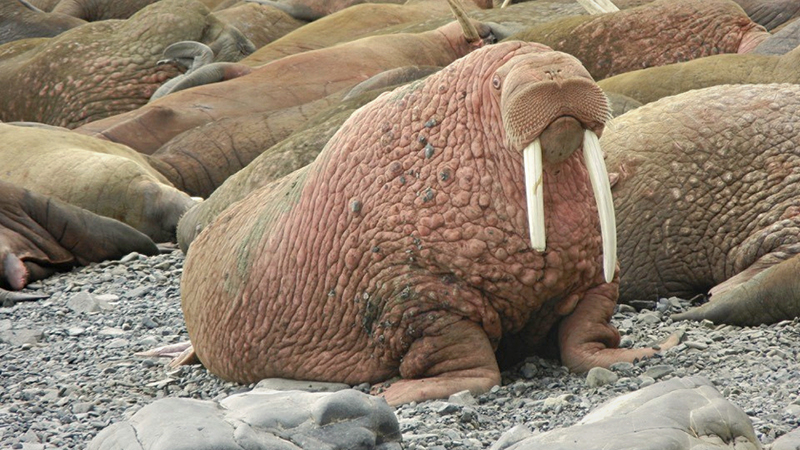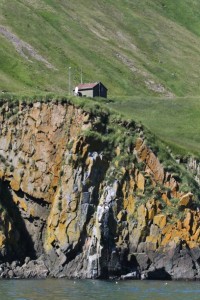By Diana Johnson, Alaska Department of Fish and Game
This is the ADF&G cabin on Round Island. It has two stories and a deck in the front, facing the ocean. The water is a ways below us, but we can see and hear walruses and sea lions coming up for air as they swim past. On calm days, we sit on the deck to eat dinner, but today, with winds blasting 20 to 30 knots outside, we’ll tuck in around the dining/working table in the cabin’s main room, where we have a fuel oil stove for warmth, a little kitchen with a propane range and oven, and a pantry stocked with four months’ food supply. The good news today is that Margaret just baked oatmeal cookies, and they’re cooling on the pans.
It is not so easy to drop by the grocery store when you’ve run out of something on Round Island. In April, Ryan Morrill and Margaret Archibald made lists of all the food they thought they’d need for the season out here, and then Ryan shopped and loaded the cans of beans, boxes of spaghetti, granola bars, apple sauce, cabbages, and so on into large plastic totes that arrived at the island by boat a few weeks later. A season’s worth of propane and fuel oil arrived on that boat, too. The system mostly works, but we do run out of some things, like chocolate chips for Margaret’s cookies, and we have lots of other things left over from previous summers, like two gallons of soy sauce.
Fresh vegetables are hard to keep up with. We have a cold hole in the ground, as deep as the two steel barrels that line its sides, in which three buckets of hardy vegetables hang on rope leashes anchored at ground level. Mostly we chase the vegetables, searching the buckets for those that are closest to the edge of going bad, and trying to come up with appetizing ways to include them in our meals. Last night I found some ears of corn, and made corn on the cob, but I wasn’t sure it would be edible. Ben said he thought the corn was tangy, but ate it anyway. We take turns with the cooking each evening, and the dishwashing, too.
Dishwashing happens in two plastic tubs, one with hot water for washing, and the other with cold for rinsing. The cabin has running water, which flows from a spring on the side of the mountain into a cistern, and then through plastic pipes down to a tap on our sink. We filter the spring water before drinking it, just in case.
Another plastic pipe leads to the shower shack, which looks like an outhouse with a hot water heater mounted in a wooden box on one side. The hot water heater runs on propane, and the box protects the flame from gusts of wind. When we want to wash a load of laundry, we can fill a metal tub next to the shower with water warmed by the heater and soap, dump our clothes in, and slosh them around with a metal plunger until they might be cleaner than they had been. We hang them behind the cabin on clothes lines strung between the outhouse and the shed. The wind blows them dry.
When chores are mostly done, and walruses and sea lions accounted for, its nice to hike up to the top of the mountain, or read, or cook something interesting. Internet also came to the cabin, along with the walrus cam, so these days there are also emails to write and podcasts to listen to. Sometimes we walk over to the first beach overlook, with a picnic or some binoculars, and just watch walruses.




